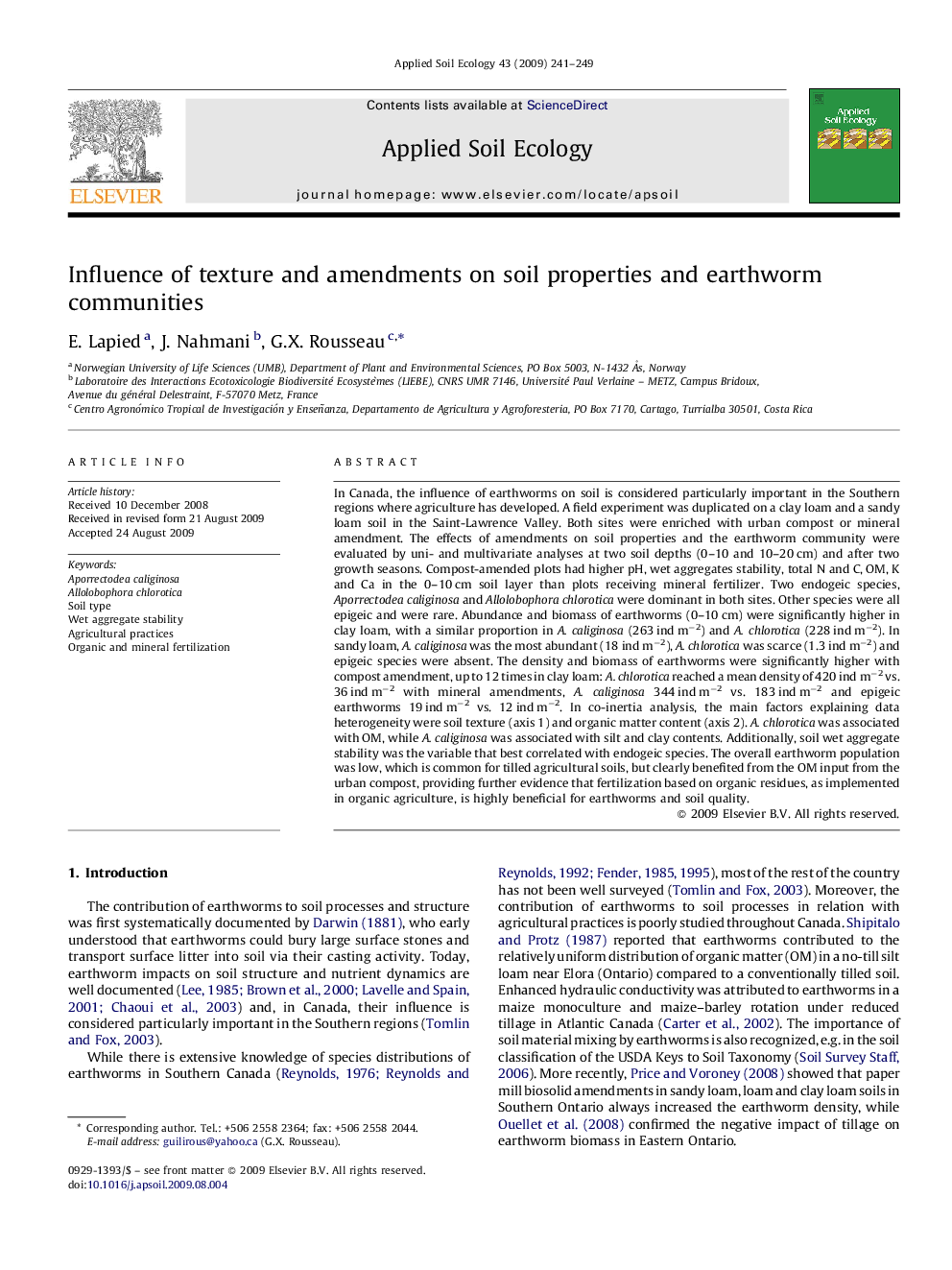| کد مقاله | کد نشریه | سال انتشار | مقاله انگلیسی | نسخه تمام متن |
|---|---|---|---|---|
| 4383070 | 1617835 | 2009 | 9 صفحه PDF | دانلود رایگان |
عنوان انگلیسی مقاله ISI
Influence of texture and amendments on soil properties and earthworm communities
دانلود مقاله + سفارش ترجمه
دانلود مقاله ISI انگلیسی
رایگان برای ایرانیان
کلمات کلیدی
موضوعات مرتبط
علوم زیستی و بیوفناوری
علوم کشاورزی و بیولوژیک
بوم شناسی، تکامل، رفتار و سامانه شناسی
پیش نمایش صفحه اول مقاله

چکیده انگلیسی
In Canada, the influence of earthworms on soil is considered particularly important in the Southern regions where agriculture has developed. A field experiment was duplicated on a clay loam and a sandy loam soil in the Saint-Lawrence Valley. Both sites were enriched with urban compost or mineral amendment. The effects of amendments on soil properties and the earthworm community were evaluated by uni- and multivariate analyses at two soil depths (0-10 and 10-20 cm) and after two growth seasons. Compost-amended plots had higher pH, wet aggregates stability, total N and C, OM, K and Ca in the 0-10 cm soil layer than plots receiving mineral fertilizer. Two endogeic species, Aporrectodea caliginosa and Allolobophora chlorotica were dominant in both sites. Other species were all epigeic and were rare. Abundance and biomass of earthworms (0-10 cm) were significantly higher in clay loam, with a similar proportion in A. caliginosa (263 ind mâ2) and A. chlorotica (228 ind mâ2). In sandy loam, A. caliginosa was the most abundant (18 ind mâ2), A. chlorotica was scarce (1.3 ind mâ2) and epigeic species were absent. The density and biomass of earthworms were significantly higher with compost amendment, up to 12 times in clay loam: A. chlorotica reached a mean density of 420 ind mâ2 vs. 36 ind mâ2 with mineral amendments, A. caliginosa 344 ind mâ2 vs. 183 ind mâ2 and epigeic earthworms 19 ind mâ2 vs. 12 ind mâ2. In co-inertia analysis, the main factors explaining data heterogeneity were soil texture (axis 1) and organic matter content (axis 2). A. chlorotica was associated with OM, while A. caliginosa was associated with silt and clay contents. Additionally, soil wet aggregate stability was the variable that best correlated with endogeic species. The overall earthworm population was low, which is common for tilled agricultural soils, but clearly benefited from the OM input from the urban compost, providing further evidence that fertilization based on organic residues, as implemented in organic agriculture, is highly beneficial for earthworms and soil quality.
ناشر
Database: Elsevier - ScienceDirect (ساینس دایرکت)
Journal: Applied Soil Ecology - Volume 43, Issues 2â3, OctoberâNovember 2009, Pages 241-249
Journal: Applied Soil Ecology - Volume 43, Issues 2â3, OctoberâNovember 2009, Pages 241-249
نویسندگان
E. Lapied, J. Nahmani, G.X. Rousseau,